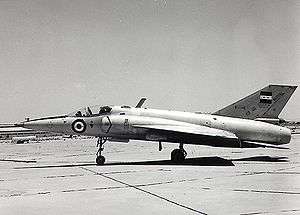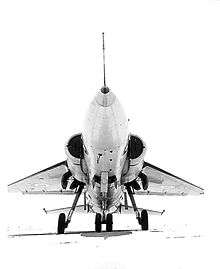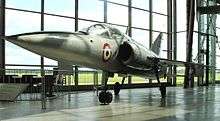Helwan HA-300
| HA-300 | |
|---|---|
 | |
| Side view of HA-300 ready for flight | |
| Role | Single-seat interceptor |
| National origin | Egypt |
| Manufacturer | Egyptian General Aero Organisation |
| Designer | Willy Messerschmitt |
| First flight | 7 March 1964 |
| Status | Canceled |
| Primary user | Egyptian Air Force |
| Produced | 1964–1969 |
| Number built | 7 (1 prototype) |
| Program cost | EGP 135 million (EGP 16 billion in 2014 values) |
The Helwan HA-300 (Arabic: حلوان ٣٠٠) was a single-engine, delta-wing, light supersonic Interceptor aircraft developed in Egypt during the 1960s. It was designed by the famous German aircraft designer Willy Messerschmitt.
At various stages, Spain and India were involved in the development program. Spain agreed to finance two projects, the HA-200 and the HA-300, but cancelled financing the HA-300 project when it was just on paper due to cost and time overruns. Egypt then financed it, and the program was transferred to Egypt where every part, including the engine, was made, and the aircraft was successfully flown.
At a late stage India financed the Egyptian development of the Egyptian E-300 engine for use on the Indian fighter jet HF-24 Marut.
The HA-300 was an ambitious and costly project for Egypt, at the time seeking to expand both its civilian and defence aviation industry.
There were 6 planes in service built before termination of the project in 1969. The first prototype was a museum exhibit as of 1997.[1]
Design and development
Origin
After World War II, Willy Messerschmitt was prohibited as a German citizen from undertaking any further research or development related to the German military, including the manufacture of aircraft, until 1955. He therefore moved to Spain where he joined Hispano Aviación and started designing an ultralight fighter aircraft in 1951.[2] The development was very slow and Messerschmitt was able to build only a delta-shaped plywood glider without a tail. Towed by a CASA 2.111, the test flight for the glider was not completed due to instability and the airplane did not become airborne.[3] Due to funding problems and the resultant long development time, Spain abandoned the project in 1960.[4]
Egypt then acquired the design. The design team, headed by Messerschmitt, moved to Helwan, Egypt, to continue its work on the HA-300, which now stood for Helwan Aircraft 300.[1] Ferdinand Brandner, an Austrian jet engine expert, was also invited to develop a turbojet for the new fighter. Egypt aimed to produce a lightweight supersonic, single-seat fighter that could join the Egyptian Air Force as an interceptor.[5]
HA-300

Development of the Egyptian HA-300 started in the test facilities and workshops in Factory No. 36 in Helwan, southeast of Cairo, under the supervision of the Egyptian General Aero Organisation (EGAO); officially the program started in 1959.
The first prototype of the HA-300, powered by a 2,200 kgp Orpheus Mk 703-S-10, first flew on 7 March 1964,[6] and achieved Mach 1.13.[7] Egypt sent two Egyptian pilots to India in 1964 to prepare for the HA-300 flight development.[1] It was followed by a second Orpheus-powered prototype which first flew on 22 July 1965. The third and last prototype was fitted with the Egyptian E-300 engine, which it was hoped would make it capable of attaining 12,000 m and Mach 2.0 within 2.5 min after takeoff. This prototype was flight-tested at least once when it achieved a speed of Mach 2.1 with the Egyptian Brandner E-300 engine.
A total of 135 million Egyptian pounds was spent on the development, and the E-300 engine was given to the Indian government for use in the HAL HF-24 Marut fighter.[8]
E-300 Engine

The HA-300 was originally designed for the afterburning Orpheus BOR 12 turbojet, but the engine did not achieve the minimum level of success Egypt required in the fighter jet. President Nasser saw from the beginning a major threat to national security by depending on a British engine, because of the hostility that time between Egypt and Great Britain after the 1956 Suez crisis.
The fighter jet was then modified for the Egyptian Brandner E-300 engine, which would have an afterburning rating of 4,800 kgp, which achieved a high level of performance.
India also helped in the funding of the Egyptian E-300 jet engine in exchange for using it as a new powerplant for its HF-24 Marut.[1] The E-300 jet engine ran successfully for the first time in July 1963.[4]
Termination
The Helwan-300 project was cancelled on May 1969. The real reason why it was cancelled remains a mystery but it can be inferred that the cancellation was due to many factors varying between technical, financial and political difficulties. The German engineers working on the design had to evacuate Egypt due to fear for their lives after they received multiple death threats from the Israeli Mossad. In order to fill the void created by the cancellation of this project, Egypt made close contacts with the Soviet Union and purchased aircraft instead of developing indigenous designs.[2][5]
Aircraft on display

- The first HA-300 prototype registration number 51-100, construction number V1, was on display since 1997 in the Deutsches Museum Flugwerft Schleissheim at Oberschleißheim near Munich. It was bought by Daimler-Benz Aerospace AG (DASA) in 1991, and airlifted to Germany for restoration at Manching. The process took MBB five and a half years to complete.[1]
Specifications (HA-300 with Orpheus 703 engine)

Data from Deutsches Museum Flugwerft Schleissheim,[9] airwar.ru,[10] theaircache.com,[11] aviationsmilitaires.net[12]
General characteristics
- Crew: one (pilot)
- Length: 12.40 m (40 ft 7 in)
- Wingspan: 5.84 m (19 ft 16 in)
- Height: 3.15 m (10 ft 33 in)
- Wing area: 16.70 m2 (179.75 sq ft)
- Empty weight: 2,100 kg (4,630 lb)
- Loaded weight: 5,443 kg (12,000 lb)
- Powerplant: 1 × Bristol Orpheus 703 or (Brandner E-300 turbojet fitted to the third prototype) turbojet
- Dry thrust: 28 kN (6275 lbf)
- Thrust with afterburner: 47 kN (10,582 lbf)
Performance
- Maximum speed: Mach 1.7 (2,100 km/h) projected Mach 2 with Brandner E-300 engine
- Range: 1,400 km (870 mi)
- Service ceiling: 18,000 m (59,100 ft)
- Rate of climb: 203 m/s (666 ft/s)
- Wing loading: 125.749 kg/m² (25.755 lb/ft²)
- Thrust/weight: 0.88
Armament
- Guns: 2 × 30mm Hispano or 4 × 23mm Nudelman-Rikhter NR-23 cannon
- Missiles: 4 × infrared homing air-to-air missiles
See also
Aircraft of comparable role, configuration and era
Related lists
References
Citations
- 1 2 3 4 5 Group Captain Kapil Bhargava. "Messerschmitt's HA-300 and its Indian Connection". MEMOIRS. Indian Air Force. Archived from the original on 5 July 2008. Retrieved 8 August 2008.
- 1 2 "Hispano Aviácion HA 300". EADS. 2008-07-20. Archived from the original on 26 June 2007. Retrieved 2008-08-18.
- ↑ Schick, Walter; Radinger, Willy (2004). Messerschmitt-Geheimprojekte : [Studien, Projekte und Prototypen für einstrahlige Jagdflugzeuge : Meilensteine auf dem Weg zum modernen Kampfflugzeug] (in German) (3. Aufl. ed.). Oberhaching: AVIATIC-Verl. pp. 149–150. ISBN 978-3925505140.
- 1 2 Ace (10 December 2006). "The Egyptian Helwan HA-300". Aviation fans. Archived from the original on 17 September 2008. Retrieved 8 August 2008.
- 1 2 Bahaa, Mohamed (2007-11-28). "Helwan-300: The Egyptian Interceptor Project". Aviation Articles. e-sac. Archived from the original on 17 February 2008. Retrieved 2008-08-08.
- ↑ Bhargava, Group Captain Kapil. "Eyewitness to the Six-Day War". The Sixties. Indian Air Force. Archived from the original on 4 July 2008. Retrieved 9 August 2008.
- ↑ "Helwan HA-300". Flug revue. 14 July 1998. Archived from the original on 4 July 2008. Retrieved 9 August 2008.
- ↑ "Helwan HA-300". globalsecurity.org. Retrieved 29 January 2016.
- ↑ "Hispano Aviacion HA-300". Deutsches Museum Flugwerft Schleissheim. Deutsches Museum. Archived from the original on 14 April 2015. Retrieved 14 October 2014.
- ↑ "HA-300". airwar.ru (in Russian). Retrieved 14 October 2014.
- ↑ Guilfoil, John M. (13 July 2012). "HA-300". Air Cache. Retrieved 14 October 2014.
- ↑ "Helwan HA-300". aviationsmilitaires.net (in French). 17 September 2014. Retrieved 14 October 2014.
Bibliography
- Bar-Zohar, Michael. and Nissim Mishal Hirschel. Mossad: The Great Operations of Israel's Secret Service. London: Biteback Publishing, 2012. ISBN 978-1-84954-543-3.
- Edgerton, David. The Shock of the Old: Technology and Global History Since 1900. Madison Avenue, New York: Oxford University Press, 2011. ISBN 978-0-19-532283-5.
- Hirschel, Ernst Heinrich., Horst Prem, and Gero Madelung. Aeronautical Research in Germany: From Lilienthal Until Today (Illustrated ed). Springer Science & Business Media, 2004. ISBN 3-540-40645-X.
External links
| Wikimedia Commons has media related to Helwan HA-300. |